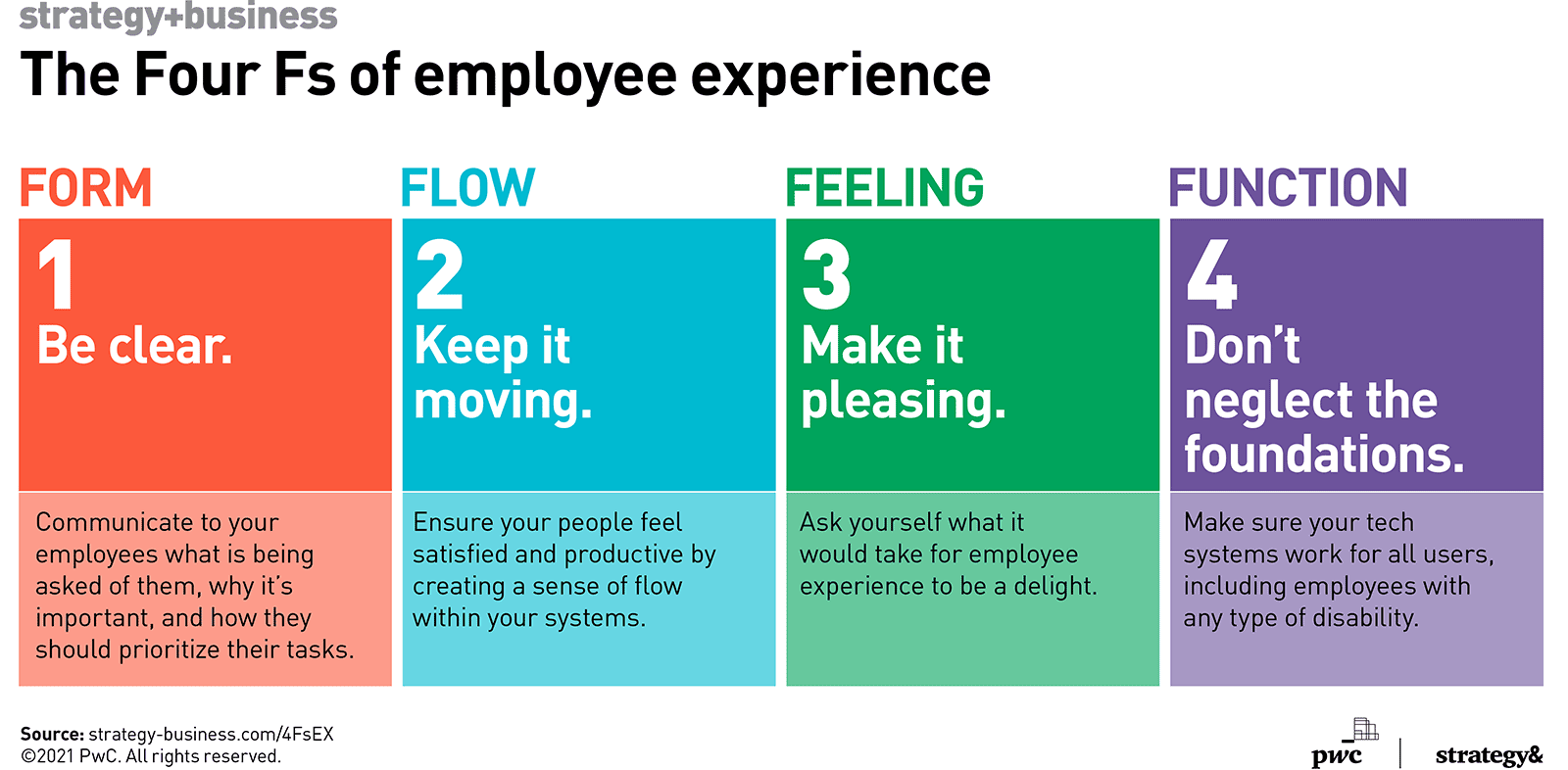The four Fs of employee experience
These simple principles, based on the empathetic, iterative practice of design thinking, can help you help your people perform to their fullest potential.
Drew, the brand manager at a large consumer packaged goods company, had been working for weeks on a summer promotion for new scents of one of the company’s leading soap brands. He spun up a website to announce the program, but then, to comply with corporate requirements, he needed to register the site with the company’s central IT department. He set aside what time he could spare in his busy day to fill out the online form required to do this, but it was so complicated and technical that Drew gave up. Frustrated, he closed the tab, making a note to revisit it on a less hectic day — which never came. Back in central IT, Joan came across the new website after a periodic audit of traffic analytics and realized the site hadn’t been properly registered. She wasn’t terribly surprised, though. Drew’s site was one of hundreds throughout the company’s domain that weren’t properly documented. Not only was this rampant problem creating tremendous work for Joan, it also meant that IT wasn’t able to vet the security of new sites or their compliance with company standards and policies before they became public.
Drew’s and Joan’s stories are all too common examples of the poor employee experiences that exist in organizations across industries. Better employee experiences make people’s lives at work easier, and go further than that to promote learning and growth, ensure safety and security, and foster connection and belonging. You probably already understand this on some level, but actually solving these employee needs can be challenging.
To deliver an optimal employee experience (EX), we recommend focusing on four principles that we call the Four Fs. They are a set of heuristics inspired by the user-centric, iterative practice of design thinking, and they rest on the idea that your business goals, experiences, and technology are inseparable from one another and must be addressed in a unified, cross-company way. We refer to this approach as BXT (for business, experience, and technology). When applied to EX, the Four Fs unlock productivity and cut down on energy-sapping frustration stemming from internal systems and tools. They are the form, flow, feeling, and function of an employee’s work life.
Form: Be clear. Employees can’t do their jobs well if they don’t understand what is being asked of them, the purpose of the work, or how they should prioritize their tasks. A firm we advised recently had received feedback from staff that the online training module for a new marketing curriculum it had developed was hard to follow and a bad experience overall. To address the problem, the company’s user experience team worked with PwC and a leading software firm to reimagine the employee learning interface. The team put the user at the heart of the design, simplifying the presentation to make the training tasks straightforward and grouping like content together. They used descriptive prompts to clarify any vague materials or instructions. And they used position, scale, and sequence to convey the digital content that users should prioritize. Anything extraneous was removed — white space was left white.
Flow: Keep it moving. Once an employee dives into a task, a sense of satisfying productivity should set in. Ensuring that your people have that experience, though, requires the ability to put yourself in their shoes and create a sense of flow within your systems. Designing these sorts of experiences can start with employees’ very first interactions with a company. A firm we work with designed its internal onboarding tool with this principle of flow in mind. The tool helps users track their progress, and it also allows users to skip any training sections they can already demonstrate proficiency in. The design team made sure to minimize the number of user actions required to progress through the tool, reducing the volume of clicks, taps, and next buttons. Companies can also enable autofill for commonly entered data fields or design systems that allow users to review and correct errors without having to start over.
When applied to employee experience, the Four Fs unlock productivity and cut down on energy-sapping frustration stemming from internal systems and tools.
Feeling: Make it pleasing. Ask yourself what it would take for employee experience to be a delight — for example, through gamified training modules or KPIs. We work with a leading technology firm that asked itself this very question and developed its tools for surveying employees accordingly, designing them to be simple and intuitive, satisfying, and not frustrating. The firm used layman’s terms and an appealing tone of voice in written content such as instructions, explanations, and requests. It avoided jargon. And it invested in interesting, stimulating visual interactions rather than ones that were bland and text-heavy — the new experience was less like a spreadsheet assignment to be endured and more of an opportunity to engage.
Function: Don’t neglect the foundations. Ultimately, employees have a right to expect that “it just works,” whether “it” is their human resources self-service portal, their expense management system, or their system interoperability. It’s also critical that user experience be accessible to all, including employees with any type of disability. One of our clients worked with its vendors to build experiences that were optimized for employees with accessibility needs and that could function seamlessly across multiple locations and devices. The solutions allowed the user to pick a task right back up when on the go or switching devices — whether it was through a company or personal smartphone, a VPN connection, or office computer.
Delivering on these Four Fs will set your company up to improve productivity and deliver powerful outcomes. But when it comes to EX, you can’t just set it and forget it. You need to build a way for employees to give robust and ongoing feedback. And with that experiential data, along with operational data, you can then adopt a methodology that we call return on experience (ROX) to leverage insights for continuous improvement and measure the impact of your EX work on value creation and realization. This system of action can be the catalyst to more agile ways of working, too, as it unlocks not only productivity but agility.
It’s time for a step change in what we ask of our teams and colleagues, and in how we respect their time and attention. The Four Fs present a new way to build employee experiences that go far further than satisfying functional or administrative needs; they help to engender a sense of community, responsibility, and pride.
PwC US principal Matt Egol, PwC US principal Richard Schweiger, and PwC US senior associate Udayan Tripathi also contributed to this article.








